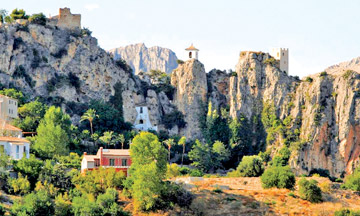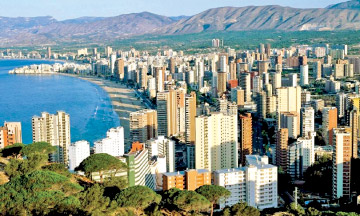Exploring Costa Blanca
Migel Hettige Mahinda Jayasinghe

The Royal Palace in Madrid |

Merino lambs |

Guadalest, the most visited tourist attraction |
 |
|
The city of Costa Blanca |
I emigrated to the United Kingdom (UK) in my twenties over
half-a-century ago and worked until retirement in 2001. As retirees, my
wife and I now live in Costa Blanca, Spain, captivated by the lure of
sea, sun and sand. The occasional glass of Sangria or red wine adds to
our sense of well-being. I am writing this on my laptop sitting on our
front terrace as the summer sun streams through cascades of red and
scarlet bougainvillea.
In this part of Spain we have not failed to notice the frequency of
organized day tours. The best known are the ‘blanket trips’ offered
entirely free of charge. You can sign up for a blanket trip at any one
of the street markets local to you. More recently a firm has been
advertising such trips in the local free press. These trips are
promotions for bedding and associated ‘merino’ lamb wool products.
Merino is a rare breed of lamb. You are not compelled to buy any items,
but have to attend the presentation which extols the virtues of merino
wool bedding. Occasionally one or two coach passengers may be tempted to
buy some of these high priced products, and that means the organizers
are able to realize a fair return, more than enough to cover the
transport costs. You also have a couple of private coach firms
advertising day trips at reasonable prices, some including lunch. There
are quite a few scenic coastal and inland towns and villages that one
could visit on such day trips.
All the coaches, as of necessity, must have a driver (Spanish) and a
tour guide (English-speaking).
It is the role of the tour guide which interests me. She is,
invariably a middle-aged lady, who tries to keep you entertained while
on the coach. She can churn out the same spiel over and over again
spiced, at times, with risque jokes. We have done quite a few of these
coach trips, sometimes with friends and visiting family members, but the
trips to a hilly promontory known as Guadalest are the most memorable,
both as free ‘blanket trips’ and paid coach trips.
There are various pick-up points for passengers on the way to these
locations. When all the passengers are comfortably seated, the guide is
ready to welcome and address us. She introduces the driver as, for
example, Jose and gives her own name as, say, Emma. By this time we
could be passing Santa Pola, on route N332, with industrial salt piles
heaped up on the roadside. She describes the origin of the salt marshes,
and what is found in the salt museum there. She points to the
possibility of us seeing flamingos, and we could be straining our necks
to see a couple far away in the distance. The watchtower that finally
succeeded in keeping the Berber pirates at bay is a landmark that we are
persuaded to admire. It has been renovated recently, but only from the
outside, she explains. Emma then describes Guadalest as the second most
visited tourist attraction in Spain, second only to the Royal Palace in
Madrid.
The next item of interest she points to, is the large outline of the
roadside black bull erected as a bill-board. I was intrigued to learn
that it had originally been an advertisement for a local brand of
brandy. At the time, it happened to be a colourful roadside
advertisement, which distracted motorists, occasioning many accidents.
The government banned it, but popular sentiment ensured its retention in
the present blacked out form, no longer advertising anything other than
that it is a Spanish emblem. Taurus is the symbol of Spain although
bull-fighting, we suspect, is now being gradually phased out.
On the way to Guadalest, now on the AP 7 motorway, we pass the
well-known James Bond (007) actor Roger Moore's former holiday home
painted an eye-catching blue. We then come across the range of mountains
referred to as the ‘Sleeping Indian.’ You have to stretch your
imagination to see a supine Red Indian wearing the traditional headdress
in the outline of the mountain range. Another story our guide tells us
is that of the legend of a giant rebuffed by an Arabian princess. In his
pique, he broke off a bit of the mountain and threw it in the sea, thus
forming an island, another favourite tourist destination, called Isla de
Tabarca. ‘If you believe that, you will believe anything’ she adds. She
also has a story about the different-coloured houses in the coastal town
of Villajoyosa, which we glimpse in the distance. When the fishermen
come ashore with their catch, they are always in a hurry to get drunk at
any one of the nearby inns. Their wives dress them in shirts matching
the colour of their houses and even if they are quite ‘non compos
mentis’ with ‘gallons’ of booze inside them, it is said that they can
all be directed towards the right house and into the arms of the right
spouse or partner, thanks to the colour-coding. That story is perhaps
rather more credible than the one about the giant.
On the ‘blanket trips’ there are sometimes items for sale on the
coach, and on the return leg, a lottery draw for some item that nobody
probably ever thinks of buying. Inevitably, it is in aid of ome charity
or other. On paid coach trips, there is always the need to sell the idea
of another, different trip next time. Often, on the return journey, most
passengers are comatose with too much food and drink inside them, and
are allowed to snooze without much chatter from the guide. In any case,
this is siesta time in Spain. At this point, Emma might remind us that
the Spanish drivers are paid so little that a small, or even a generous
tip, would be most welcome. The collection plate is passed from hand to
hand.
As a parting gesture the tour guide recounts jokes that wakes
everyone out of their slumber guffawing, and presumably, leaves the
passengers with a favourable impression both of the guide and the
company she works for. One of her harmless jokes, I remember, goes like
this. A mushroom enters a bar and asks for a carajillo (coffee laced
with brandy). The barman says ‘We don't serve your sort here'. The
mushroom looks surprised and says ‘Hey look, what's wrong with me? I am
a fun guy (fungi)! Another is that of the two nudists sitting on a park
bench. They have been talking about their respective intellectual
pursuits when one of them gets up. The other, continuing with the
conversation says. ‘Of course, you have read Marx!’ The risen nudist
rubs his bottom and replies. ‘Red marks? We have been sitting here far
too long!’
This is the sort of life retired expatriates, like us who live in
Spain's Costas enjoy. They know that they have only a few more years and
want to indulge in harmless diversions while still alive on earth.
Indeed, the World Health Organizations (WHO) has put on record that
living in this part of Spain, eating a Mediterranean diet, can prolong
your life span by an extra ten years. |





